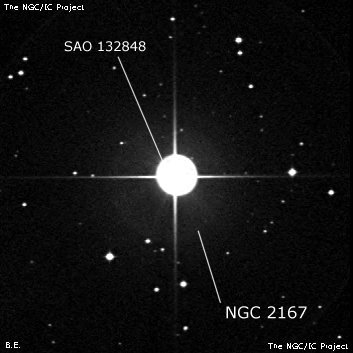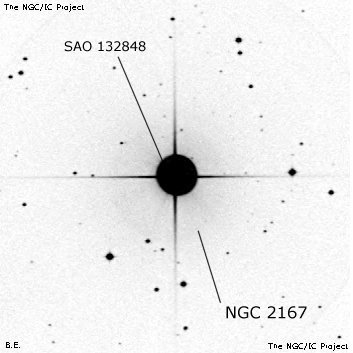NGC/IC Project Restoration Effort
(This is a very very beta version)
NGC2167


Basic Information
Location and Magnitude
Right Ascension: 6:6:58.6
Declination: -6:12:10
Constellation: MON
Visual Magnitude: 6.6
Historic Information
Discoverer: Herschel J.
Year of discovery: 1831
Discovery aperture: 18.3
Observational
Summary description: Nebulous * 7, am 3 st
Sub-type: *
Corwin's Notes
=====
NGC 2167 is SAO 132848; it is certainly not H IV 44. This error comes from JH
who equated his own h378 with his father's "planetary" more than 10 arcmin
south-following his (JH's) position. Dreyer followed JH in NGC, but when he
prepared WH's papers for their re-publication in 1912, he realized that WH's
description as well as position did not agree with JH's. Dreyer gives some
additional information in his note in WH's Collected Scientific Papers, and
also suggests there that WH actually observed a nebulous star about 70 seconds
of time following JH's position. This suggestion was the source of my own
comment in the preliminary version of ESGC that the RA of N2167 is 1 minute of
time too small. Wolfgang agrees with this as WH's description very clearly
fits, and Dreyer also describes the same group of stars with its attendant
reflection nebulosity (van den Bergh 68).
In the earlier version of this note, I went on to say,
I think now that Dreyer and I were wrong. The description of IV 44 fits
IV 19 = NGC 2170 very nicely, and the RA's are the same. The Dec's are
about 8 arcmin different, and IV 19 was not seen in the sweep in which IV 44
was found. Therefore, it is likely that the only error in NGC is calling
N2167 "IV 44."
Is there, however, a problem with JH's observation? The star at his
position has almost no trace of nebulosity around it. Yet JH does not mark
the position as uncertain, and that position is within 20 arcsec of the true
position of the star. And JH calls it a "star 7 m;" its V magnitude is 6.9.
By contrast, the star in NGC 2170 is 9th magnitude, and the star that Dreyer
suggested as IV 44 is 11th magnitude. Perhaps there is a trace of
nebulosity hiding in the overexposed image of the bright star. A close
visual examination is needed.
When I wrote all of that, I had not seen WH's full description for IV 44:
"A star involved in milky chevelure, situated betwee[n] two stars, with a
3[rd] star at rectangles to the former two." (See the Note on H IV 44 in the
"notngc" files for more about this.) That clearly does NOT fit NGC 2170, but
is a nearly perfect description of vdB 68 as I note above. Dreyer says the
same thing in his note in the Scientific Papers, Vol. 1, page 368.
So, the identifications are as follows: NGC 2167 is SAO 132848 = HD 41794;
NGC 2170 is SAO 132861 = BD -06 1415; and H IV 44 = vdB 68 is involved with
HD 42004 = SAO 132867.



